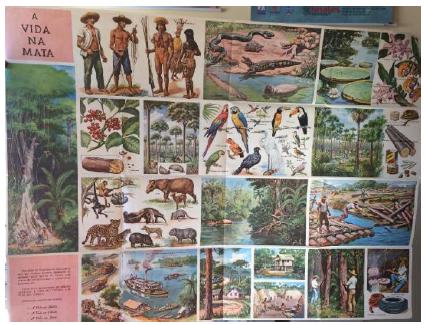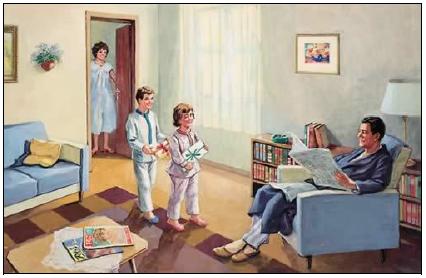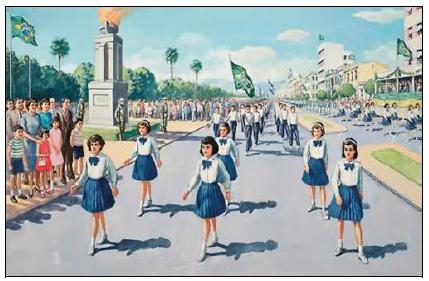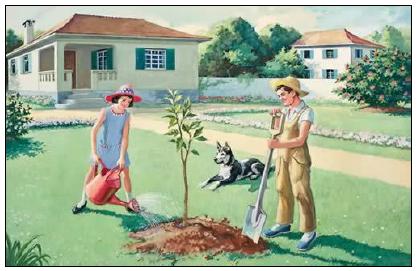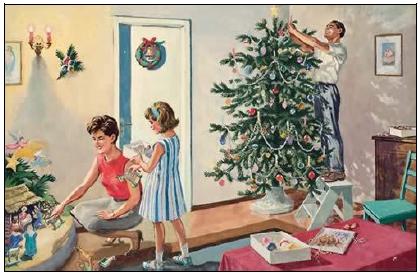Images potentiate words.
Gabriel García Márquez ([1997] 2011, p. 101)
INTRODUCTION
Images at schools are widely known for their cultural and social importance, present from infant education to University, not only as an auxiliarymethod or support of teaching, but also as an object of studies (RENONCIAT, 2011, p. 5). It is a proposal of protocol for reading suggesting to the reader the understanding of the text and its meaning. In this paper “ it may be a place of memory that, in a single representation, crystallizes a story, an advertisement, a teaching, or then is constructed as a moral, symbolic, analogical figure that supplies the global meaning of the text, which could be lost in a discontinuous and careless reading.” (CHARTIER, 1998, p.15). For the author, the images are not mere illustrations inserted into the school space, there is always a possibly unconscious motivation for their use, as to how and where they will be utilized.
Iconographic production for pedagogical purposes is a useful tool to represent reality, enabling the analysis both of the image to see and of the image shown . The image not only complements the text, but is also the protagonist of the written message when it brings to the school the world as it should be perceived. The images representing both visible and invisible things are texts that can be read leading the student to an interpretative activity regarding what is real from the association of ideas. (CHAMEL, 2004, p.52 e 72).
The intuitive method which goes from the facts to the ideas is based on the principle that knowledge results from the senses, from the fact of seeing and touching the objects, which gradually allows the student to construct the abstract idea , to compare, to generalize, to rationalize without the need for material examples (RENONCIAT, 2011, p. 79). In this way, when direct observation is not possible, the mural pictures are the devices that carry out this function of representing reality.
Based on these considerations, the objective of the present article is to show the Revista do Ensino/RS, especially the didactic supplements or mural images as a detachable monthly supplement, also called “Teaching Materials for the Elementary School Classes” (BASTOS, LEMOS, BUSNELLO, 2007).
Approaching the mural images as an expression of the school liturgy and educational universe of a given period of schools in Brazil and Rio Grande do Sul, the subject of analysis in this study are the mural pictures drawn by the Austrian immigrant Carl Ernest Zeuner (1895-1967)2, 61 of them, drawn in tempera on paper to become part of the Revista do Ensino/RS teaching supplements, during the period from 1963 to 1969. They are in the collection of the Ado Malagoli Art Museum of Rio Grande do Sul (Museu de Arte do Rio Grande do Sul Aldo Malagoli) (1982)/MARGS and have been digitized 3.
As to the methodology used to analyze the Zeuner pictures and the mural pictures, we would look more closely especially at their objective as a pedagogical device in elementary schools in the 1960s. Dubois (2004) considers that there is no method to analyze images. It begins with the idea that “the image we have before us is at the same time an object of culture and an object by nature. It is an object of culture about which there is a huge amount of knowledge and it is necessary to master this knowledge in order to approach the images.(...) An image is also something in itself, which has a power of its own and does not originate in the knowledge constituted about it” (In: FERREIRA; KORNIS, 2004, p. 152-53).
The Revista do Ensino/RS (1951-1978): Teaching by image4
The Revista do Ensino magazine began to be published in September 1941, as an initiative of elementary school teachers. With the institutional support of the Department of Education and Culture of the state of RS (Secretaria de Educação e Cultura/RS), on Dezember 11, 1956, the journal became an official publication. Under the technical supervision of the Center of Research and Educational Guidance (Centro de Pesquisas e Orientações Educacionais - CPOE/RS )(1943-1971)5, it disseminates the pedagogical advice of the research center6. The intention is not only to “fill the empty place next to the elementary school teacher, trainee or not”, but also the hope that the young and idealist female educator would find in its pages the solution to “resolving the arduous , but sublime, problems of their profession “. In this sense, the magazine aims to preponderantly guide the elementary school teachers of Rio Grande do Sul, disseminating technical-pedagogical guidelines, teaching materials and the legislation involved in teaching.
Iconography was present in the Revista do Ensino/RS in three ways: the covers, which reproduce photos of everyday school life and/or graphic compositions elaborated by the editorial staff; the back covers used as a space for teaching material and advertisements; and the teaching supplements or mural pictures, a detachable monthly supplement. The periodical had a permanent staff for planning and illustration. Many of thse professionals remained throughout the existence of the publication and were responsible for the graphic finish and the conceptual and esthetic balance of the periodical.
The intense stimulus of iconography in the classrom reflects the materialization of the didactic-pedagogical discourse of the CPOE/RS, based on the foundation of the renewed school - “ the implementation of active methods: the centrality of the child in the learning process; school as a space to exercise creativity; the development of self-discipline, of individual freedom, of the moral conscience of the children who are being educated; development of a critical spirit; understanding reality”. These were the aims of the Center aiming a accompaning the “changing civilization” and the challenges of life in a democratic society (GARCIA, PERES, 2002, p102).
The pictures, to be used in the classrom, are colored, 44cm by 37 cm, with perfect graphic finish, on specific topics, organized as a series of pictures: zoology, language, history7. From 1960 onwards, the editorial staff modified the graphic presentation of the supplemental graphic material. It became much larger (80cm x 107 cm), it provides the teacher with guidance on the supplement itself (on the reverse side), it presents the topics of the elementary school disciplines - language, mathematics, natural sciences, history and geography- in a single picture with legends.
In 1965, when the magazine came under new management, there were also changes in editorial and graphic design. A few covers began to be drawn, and the didactic-pedagogical guidance of the supplemental didactic material began to be called “How to use the supplement”, approaching different topics of the disciplines of the elementary school curriculum.
This section always presents the staff responsible for guidance and layout, for planning and for the drawings. For the supplement The year in seasons (nº108, 1966) (O ano em estações) the person responsible for the guidance and layout is Professor Maria Madalena Lutzenberger, planning is done by the teachers Maria Aparecida Grendene and Ercila T. Ambros, and the drawing by Carl Ernest Zeuner and Elsy Pires Ferreira. This distribution of tasks expresses the concern of the editorial staff both with the didactic-pedagogical issue and the iconography.
The iconography was made available for all disciplines of the elementary school curriculum, together with guidance on how to use it in the classroom, to make mural pictures, to use audiovisual resources. The cumulative index per topic of the magazine chooses pictures and prints as a category to classify the content subdivided into: our covers, school calendar, natural sciences, social sciences, drawing, Brazilian geography, foreign geography, hygiene, Brazilian history, language, music.
In general, the didactic-pedagogical suggestions of Revista do Ensino are limited to guiding initial and internal reading of the illustration itself, to identify its content. The sequence of observations, descriptions and narrations is very important, since it creates texts - oral and/or written, which allow the student to establish relationships with other contexts and experiences. However, an external reading is also needed to enable the identification of other referentials that characterize the image as an object - how and why it was produced, for what and for whom it was done, when it was done - enabling a more critical and analytic reading (BITTENCOURT, 2002, p.88).
THE MURAL PICTURES OF CARL ERNEST ZEUNER (1963-1969)
Karl Ernest Zeuner was born inZwickau , near the German border with the Czech Republic, on August 13, 1895 and graduated from the Academy of Graphic Arts of Leipzig/Germany. In 1922 he came to Brazil, and settled in Porto Alegre, state of Rio Grande do Sul. He was a painter, a draftsman and illustrator, working for four decades at Globo Bookstore and Publisher (Livraria e Editora Globo)8, and was in charge of the graphic arts studio, specifically the department of drawings and graphic planning. He was an illustrator of the Revista do Globo9, magazine, and many books. He also designed packaging, advertisements, tax stamps, calendars and encyclopedias, cards. He trained many graphic artists of Rio Grande do Sul. He died in Porto Alegre in 1967, at the age of 72 years10.
Based on the idea that the mural pictures of Carl Ernest Zeuner in the Revista do Ensino/RS expressed a language made of images, we analyzed the pictures conserved at MARGS. Of a set of 60 illustrations made for the periodical, 30 were lost and the others were donated to MARGS (Art Museum of Rio Grande do Sul) by SEC/RS (GOMES, 2001, p.88). It is believed that later there were further donations, a total of 61 pictures, 8 of them untitled11. We also analyzed the collection of HISALES/History of Teaching Literacy, Reading and Writing and of the school books at the Faculty of Education of the Federal University of Pelotas/RS, that, in April 2017, received the donation of a major set of mural charts attached as supplements to Revista do Ensino/RS12. The collections allowed a look at what was really published and the composition given using the Zeuner drawings.
The dates from 1963 to 1969, as identified by MARGS, are due to the fact that many pictures were published even after his death (1967), until the 1970s. From 1965 (RE/RS, nº100) to 1966 (RE/RS nº110), Zeuner is always present in the credits of the Teaching Supplements. His name will later appear in issue 124 of 1969, with the picture “Brazilian life in the Colonial Period I”. These data allow thinking that other pictures were painted besides those found.
Gomes (2001, 85) points out that Zeuner did his work both in guache (an opaque paint in which there is gum arabic dissolved in water and honey or some similar substance ) and in water colors. He highlights the originals pained in guache - the illustrations of the series “Aspects of Life in Brazil”, created for Revista do Ensino/RS and printed in offset in the printing shop of Globo Publishing House.13. There were sixty painted motifs of the different regions of Brazil, to be used by teachers and students, as didactic “scenarios” in the classroom.
About “ Aspects of Life in Brazil”, Nelson Boeira Fäedrich (1983) writes: “the art Zeuner placed in these temperas transcends the simple objective of being transformed into teaching materials. In originals measuring only 32x12cm, the artist once again showed impressive technical knowledge. Because of the details they present some works appear to be the work of a miniaturist” (apud GOMES, 2001, p.88). The pictures were done on paper. They were small (32x12cm), but printed large (80cm x 107 cm) and folded into four to be inserted in the periodical, which was 29cmx22cm, a standard A4 sheet.
The set on “Aspects of Life in Brazil” is divided into several series, many of which are incomplete:
- Life in the city (15 pictures); The Factory; The Workers; Sociocultural aspect of the Community; Characteristic aspects of a city; Central aspects of a city; Light and Water; Hydropower plant; Media - telephone, television, radio, post office ( (Pequena História da Comunicações (suplement nº 104, 1964); Means of Transport (supplement nº137, 1971); The Port; Child recreation: the Park; Supermarket - shopping; Rescue Service- frogmen; Overview of a city: untitled image - large buildings; community employees (Profissões a serviço da Comunidade I, supplement nº 119, 1968; Profissões a serviço da Comunidade II, nº 122, 1969).
- The year’s main celebrations in the city (8 pictures): Easter; Arbor Day; Labor Day; Mother’s Day; St John’s ); Father’s Day; Independence Week; Christmas (supplement nº 110, 1966; nº114, 1967);
- Human Work, Brazilian Industry (1 picture): Aspects of the Industrial area of the city (supplement n°100, 1965; nº102, 1965; supplement nº 108, 1966; supplement nº 109, 1966);
- Life on the Coast (10 pictures): Fishing in the South; The beach; Dunes; Cliffs; Island and Lighthouse; Fishes and their products; Fishmonger in the Northeast; Fishing in the Northeast; Fishermen; Salt pans (supplement 29, nº 81, 1962; nº39, sep. 1963); supplement The sea, beautiful wild sea (nº166, 1977);
- Life in the Countryside (7 pictures): Coffee Picking; Slaughtering cattle and the charqueada (salted beef industry); Means of transport; Planting and picking cotton; Planting and picking coffee . Planting and harvesting wheat;Cattle roundup (supplement nº 30, 1959).
-Life in the Mountains (11 pictures): Mineral waters; Beasts of burden; Extractions of gold and precious stones; Media; Means of Transport; Coal mine and quarry; Hydraulic power; Hydropower plant; Different vehicles; Viticulture; Wood.
- Life in the Forest (9 pictures): Means of Transport; Means of Transport by Waterway- wood; Types of boats in the Amazon Basin; Victoria Regia; Rubber pickers and extraction products; Guaraná; Carnaúba extraction; Human types.
- Human types (2 untitled pictures):
Sydia Sant’Ana Bopp, in the article “Pictures in teaching language” (nº 55, sep. 1958, p.32), presents a classification in three types: complete pictures, when the child only needs to narrate, tell what the figure shows; incomplete pictures, when they present a part of the fact, leaving the rest to the child’s imagination; pictures that illustrate facts whose purpose consists of broadening children’s experiences, especially those of a historical and geographic nature. In the latter type, we have practically the entire series produced by Ernest Zeuner.
Cross-referencing the information of the MARGS collection, with the Cumulative Index of the Revista do Ensino, the references of the Supplements of the Month and the Hisales collection, it is found that many pictures in the set were published. However, the MARGS collection does not include some productions in which the drawing was by Carl Ernest Zeuner and Elsy Pires Ferreira. For instance, in the The Year in Seasons (nº108, 1966), it can be perceived that the four most significant images on the topic are by Zeuner. It is believed that Ferreira’s participation was restricted to the composition of the mural and the insertion of small human figures to compose the empty spaces.
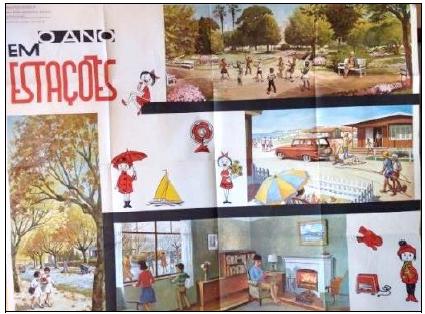
Source: Revista do Ensino/RS, n.108, 1966, p.64.
Figure 3: Teaching supplement “The year in Seasons”
Zeuner also participated with drawings in the supplement “Brazilian life in the colonial period I” , together with Nilza Grau Haertel14, which emphasizes that
(...) we highlight an overall view of the two population centers of the time : the city - where there is trade, which leads to one type of social organization - and the sugar mill, where the main tonic is production, and it gathers around itself another type of social organization attempting to remain independent from the city. As a complement, we show architectural details, utensils and objects to decorate the interiors of houses used in Colonial Brazil, which will show the students the characteristics of that phase, so that they will perceive the influence of the colonial style in the current tendencies of architecture and Brazilian decoration ((Revista do Ensino/RS, nº124, 1969, p.64)
Figure 4, below, shows that the mural image was composed by thirteen pictures, of which only the four colored ones allows identifying them as Zeuner’s work..
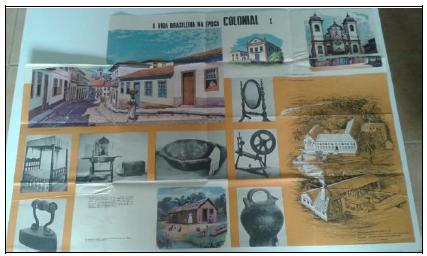
Source: Revista do Ensino/RS, nº124, 1969
Figure 4: Teaching supplement: “Brazilian life in the colonial period I”.
The entire series of Life in - the Coast (nº29), the Countryside (nº30), the Forest (nº31?), the Backlands (nº97), the City (nº98), the Mountains (nº99) -, from the pictures in the MARGS collection is significant for the number of small pictures, with a wealth of details and colors. We located only the “Life in the Forest” supplement (Figure 5), which enables to explicitly show the quantity of small pictures, a total of 17. From this image we can identify 14 pictures by Zeuner. Three pictures are of animals that are found in this habitat: animals, birds and reptiles, whose images may have been taken from books to complete the supplement.
Among the various pictures we chose to analyze those that we consider more representative of the school universe. The set selected refers to school festivals during the school year, which can be classified as civic, religious and social events15. For Rodrigues (2010, p.97), “the festivals help form a way to construct and disseminate references and national symbols, integrating the collective national memory ”.
The set of “Main Commemorations of the Year I” (RE/RS, nº110, 1966) presents pictures about Christmas, Mothers’ Day, Easter and St John’s; and “Main Commemorations of the Year II” (RE/RS, nº114, 1967) lists the holidays of the second half of the school year, except for Christmas, with pictures about Arbor Day, Labor Day, Father’s Day and Independence Week. Guidance on”How to use the supplement”, points out:
The pictures in this supplement can be presented as an incentive to develop units concerning the dates highlighted. They will also be used as the motif for oral and written compositions. These compositions, depending on the level of the class may consist of an enumeration of elements in the picture; elaboration of sentences, mentioning the characters, the facts, the main actions; elaboration of short stories, stories and poems. The students can also tell their own experiences involving the content of the pictures and collect music and poems referring to these commemorations. The teacher must make the students feels the Christian spirit of dates such as Christmas and Easter, remembering that holidays and gifts are ways of showing joy for the religious events and not the primary reason for them. (RE/RS, nº144, 1967)
It was recommended that the two holidays -Christmas and Easter- were to be exalted as religious celebrations, in which the Christian and not the commercial spirit was to be emphasized. In the body of the periodical were numerous detailed guidelines for each commemoration, involving the organization of a program, texts and activities for the different disciplines, both for the teacher and for the students, music, plays, drawings, clippings.
The school year begins with the Easter Holiday, drawn by Zeuner through an activity to prepare for the holiday in a class room, shown in the figure below.
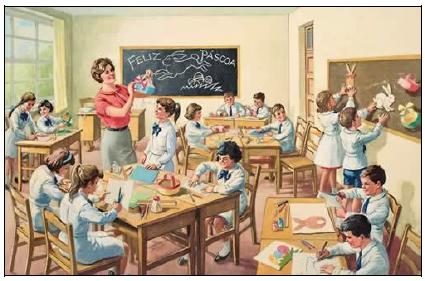
Fonte: Collection: Margs. Suplemento da Revista do Ensino/RS, nº110, 1966.
Figure 6 Easter Holiday. Drawing by Carl Ernest Zeuner.
The picture expresses, in precious details, a classroom of a public elementary school (grupo escolar). This finding is supported by the clothes worn by the children: the uniform adopted by the State and mandatory for elementary schools - consisting of a white smock, and a navy blue ribbon or tie. The room has a blackboard, table and chair for the teacher, fourteen tables and chairs for the students, eight girls and six boys. They are organized in pairs and/or groups of four. The activity is to draw and cut out motifs regarding the Easter holiday (bunnies, eggs, making small baskets), to decorate the classroom and the mural. On the tables there are various kind of materials: stiff paper(cartolina), scissors, paints, coloring pencils.On the blackboard is written “Happy Easter” and a bunny is drawn with eggs on a small lawn. The elementary school teacher is interacting with the the girls in a group and analyzing the small basket for the eggs, probably made by the student who is standing. A boy and a girl are placing drawings on the mural - a stylized bunny face and a bunny, on which there is already a large egg, a basket. The rabbit attached is similar to the model present in the magazine and drawn on the blackboard, about which we can infer that the tracing was reproduced for the students only, for them to color in and cut out. The image shows an ideal, harmonious, quiet classroom, with interaction between students and the teacher, who we can think is elegantly dressed for the standards of that time(1960s) considered the “golden years” of Rio Grande do Sul schoolteachers. (FISCHER, 2005).
Labor Day is a worldwide holiday, always celebrated on the first day of May. Nowadays few schools commemorate this day. However, in the 1960s it appears to be part of the calendar of school holidays or topics, as in the figure below.
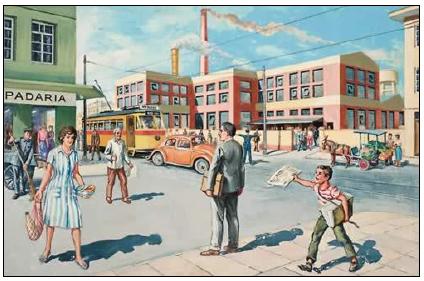
Source: Collection: Margs. Suplemento da Revista do Ensino/RS, nº110, 1966.
Figure 7: Labor Day. Drawing by Carl Ernest Zeuner
The picture shows a scene in an urban context, emphasizing an industry or factory, the bakery, a tram, a Volkswagen car. The passersby who are part of the landscape, are the workers leaving the factory, the traffic policeman, the greengrocer with his cart and his products, a uniformed street sweeper. In the foreground there is a woman with her shopping, a gentleman wearing a suit and carrying a briefcase, waiting to cross the street, and highlighted, a boy who delivers newspapers, that is, children’s work for boys from low income families16. This set aimed to show children the different activities developed by man, the many different professions in urban centers, aiming to “make the child perceive that they are all useful and necessary to the community, and thus deserving of all our respect” (RE/RS, nº114, 1967, p.64).
Picture 8, below, is part of this first picture that contains more than seven images connected to the wine and lumber industries, products that are useful and comfortable, raw materials, products for processing. The subtitle of the second supplement is “Industry also contributes to national security”, adapting to the central concern of the Military Dictatorship implemented in 1964. The picture consists of 11 images which are highlighted by titles: products for usefulness and comfort, supplying energy, food products, paper industry, parts that make transport easier, producing metals, building transport and defense vehicles, making communications easier. The third supplement is only titled: “Human work and the Brazilian industries”, containing 15 images. The purpose of these three pictures is to “evidence industrial activity in the present day”, which the teacher can explore in different disciplines (language, mathematics, social studies), grouped by Brazilian regions and purposes. For instance, food, clothing, transport and other industries. The last two supplements are different from the others, because they emphasize the images with small titles, giving direction to the students’ gaze.
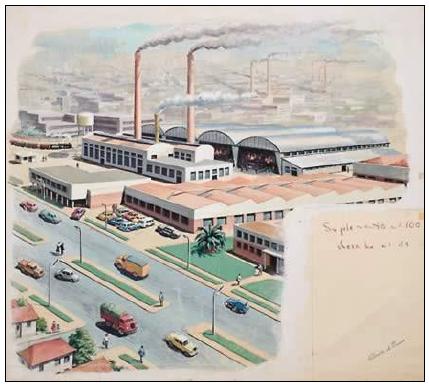
Source: Collection: MARGS. Drawing by Carl Ernest Zeuner (RE/RS, nº100, 1965)
Figure 8: Human work, Brazilian industry. Aspects of the Industrial district of a city.
In the series “Life in the City”, we also observe that Zeuner attempted to portray many professionals, identified as “community employees”, seeking to show the student the importance of work. In figures 9 and 10, below, the image presents, in the foreground, a traffic policemen who is helping the children cross the street from the elementary school, with other children to the right of the image. This picture allows observing the draftsman’s concern in approaching his graphic representation of everyday life at school.
Mothers’ Day , commemorated on the second Sunday in May, is shown in the private and domestic environment of the home, with a middle class core family (father, mother and three children), all of them smiling. The youngest child gives the mother flowers. The table is laid to celebrate the day, with cake and soft drinks that are brought by the father, dressed socially in a shirt and tie, which denotes a formal standard in everyday life. According to Burke (2004, p.109), the pictures of domestic interiors must be problematized regarding what should or not be shown. From this perspective, the environment drawn reveals a harmony that does not necessarily correspond to the families of the public school students, to whom they were addressed.

Source: Collection: Margs. Suplemento da Revista do Ensino/RS, nº110, 1966.
Figure 11: Mother’s Day. Drawing by Carl Ernest Zeuner
In order to represent this June festival, commemorated on Saint John’s day (June 24, considered the longest night of the year in the southern hemisphere, celebrated with bonfires), the scenario chosen by Zeuner was to emphasize the fun and games around the fire, where all are dressed as “peasants”. In the background the picture shows adults and a large table with party food. Seated on the bench at a table is a boy playing the accordion. It appears to be a large public space, not necessarily a school yard..

Source: Collection: Margs. Suplemento da Revista do Ensino/RS, nº110, 1966.
Figure 12: June Festival. Drawing by Carl Ernest Zeuner
The supplement “Main commemorations of the year II” (RE/RS, nº114, 1967, p.64), with pictures referrng to Labor Day, Arbor Day, Father’s Day and Independence Week, recommends as activities making “oral and written compositions, short stories, longer stories and poems”, that , depending on the level of the class, may consist of “enumeration of elements of the picture; writing sentences, mentioning the characters, the facts and the main actions”.
Father’s Day, identified with the diminutive “Daddy”, commemorated on the second Sunday in August, shows the family moment, in the morning, when the children still wearing pajamas, bring presents to their father who is seated in an easy chair reading the newspaper. The mother spies the scene from the living room door. It is interesting to observe that, differently from Mother’s Day, the magazine publishes very few texts, music, poems and activities for the date. We may think that the father, as family provider, was not available for school activities, or that it was considered a minor date as a result of the emphasis given by the Catholic Church to the figure of Mary in relation to the mother.
The picture about Independence Week (Semana da Patria)17 shows the Youth parade on September 7, in front of the National Flame, at that time placed in Redenção Park and João Pessoa Avenue, in Porto Alegre, Rio Grande do Sul. In the foreground, junior and senior high school students. Girls followed by boys, both in uniform and bearing the Brazilian flag, parading in front of the Flame where families are standing with children. In the background one sees a large public watching and students marching.
In various issues of the periodical, official guidelines are given for this date. In issue 107 of 1966, the Communiqué and Official circulars of CPOE/RS for Independence Week are published with the schedule of activities for that week, which included explaining to the students “why one celebrates Independence Week”.
The picture drawn for Arbor Day or Festival 18 celebrated on September 2 shows a tree being planted by two young people in the garden of a house (Figure 15), which inferring the objective of encouraging an attitude and/or an “ecological conscience”, according to Rodrigues (2010, p. 119). The activities recommended for this festival sought to emphasize the value of planting trees in the city, both for their esthetic aspect and to “freshen the air”.
In issue 106 of 1965 (p.63-64), the guidelines to explore this date recommended studying the tree and “how it looks during the different seasons of the year and its parts”, but also the different materials that the tree offers man. It emphasizes that it is useful to make the student “aware that for ancient man [the tree] was the greatest source of materials” for life. It also suggests that, besides wood, it should be emphasized that tree bark and leaves are used to manufacture paints and fibers, paper, and as a source of food for man. As an activity outside the school it is suggested that the students visit a furniture factory.
Christmas in the figure below is identified as “one of the main commemorations of the year in a city”. In December at the end of the school year, tests and examinations culminate in the final delivery of the results and preparation of the Christmas spirit. In this sense the periodical shows a significant number of activities, music, poems about this date. Zeuner shows this date agains in a domestic environment, where the family is involved with Christmas decorations: the father is decorating the pine tree, the mother and daughter are fixing the Crib. A small detail of a picture hanging on the wall, next to the lamp, that reproduces the image of a saint, shows evidence that the family is Catholic. However the Christmas celebrations also involve other religions.
FINAL WORDS
The images analyzed here express an illustrator’s reading of creating didactic devices for use in the elementary school classroom. The landscapes drawn represent an idealized image of a reality that was not that of most students in public school at the time. The meaning of this set, drawn by Zeuner and published in teaching supplements must be analyzed from the point of view of its “social context” and its main intention (BURKE, 2004, p.225). They were drawn to “persuade or oblige students to interpret things in a given manner” according to the guidelines suppplied by the periodical..
The study of images as a archive of the school memory and of educational practices is an (in)formation device. By using iconography extensively in its editorial production, Revista do Ensino/RS, aimed to popularize the visual resources in the classroom and to organize the school curriculum not as a simple representation of “reality”, but rather as a broad symbolic system (SAMAIN, 1996). Thus the process of teaching literacy in elementary school also involved visual literacy as a source of knowledge and intelligence. The image was to impregnate the child’s soul as a further device producing a didactic-pedagogical message.
From the perspective of the new school, learning to see is an essential condition for experimentation activities. Thus, pedagogy through images or in images seeks to “didacticize “ the look, enshrining a representation of a given reality limited to the manifest content for detailed guidance in its exploration by teaching, removing the likelihood of other possible views and interpretations.
Iconographic reading as an educational activity, develops a critical look, teaches how to learn to see the world and organizes the experience, giving sense to the images (MARTELLI, 2003). The image does not act as a mere illustration, but has a formative function for the social imagination, a major vehicle for acculturation of the individual, it perpetuates identities, values, traditions, cultures.
Teaching through the senses and education for learning the senses significantly marks the primacy of the observation regarding experimentation in school practices. Teaching reading, history and geography, the moral, civic, religious and patriotic formation was present in the pictures by Zeuner. Feldman (2004, p. 94) emphasizes the educational function of the images in the classroom: they represent the world according to standards involving morality, practicality and homeland; they represent reality in a stereotypical and idealized manner, organizing it and simplifying it; they impose an order that coincides with the standards of the curriculum.
The study of the images - advertising posters, anouncements, illustration of didactic books and pedagogical magazines, photographs, maps, films, slides for overhead projectors, photographic slides, works of art, drawings, comic books, etc. -offers multiple possibilities to read the school culture, as a pedagogical discourse and not as a merely decorative element.
Iconography in the classroom, with various kinds of supports, is a current topic and deserves the attention of educators, to create situations that will make the students reflect on the temporalized images in a society that is increasingly dominated by images from the media.











 texto em
texto em 



